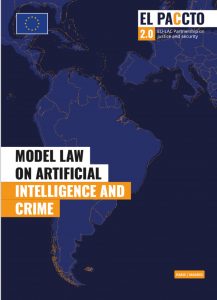Strengthening Justice in the Age of AI: EL PACCTO’s Model Law on Artificial Intelligence and Crime

Artificial intelligence is rapidly evolving and is being deployed to the meet the needs of organized crime. Organized criminal groups currently use and deploy AI for a range of criminal purposes, including automating phishing, malware distribution, and identity theft using AI to craft personalized or multilingual messages at scale, generating deepfake audio, video, and images for impersonation, blackmail, and fraud schemes, making scams more credible and harder to detect, deploying bots to conduct reconnaissance, generate fraudulent accounts and information, and conduct financial fraud with greater speed and efficiency, orchestrate complex cyberattacks through DDoS and ransomware that dynamically adapt to targets and evade traditional detection and exploit and abuse children through generative AI images.
To meet this challenge, EL PACCTO has launched the first Model Law on Artificial Intelligence and Crime, an innovative instrument designed to enhance regional and international cooperation across criminal justice systems. This model law equips investigators, prosecutors, judges, and magistrates with a forward-looking legal framework to investigate, prosecute, and adjudicate crimes stemming from the misuse of AI technologies. Initially developed for Latin America and the Caribbean, the Model Law offers a flexible structure that can be adapted by countries worldwide to their specific legal and institutional needs. The Model Law covers all key dimensions of modern criminal justice cooperation:
– Substantive law: criminalization of AI-related offenses, aggravating circumstances, conspiracy, and organized crime.
– Jurisdiction and competence: clarifying jurisdictional aspects and national court responsibilities in cross-border AI cases.
– Procedural measures: incorporating victim protection, procedural safeguards, and international cooperation measures and mechanisms.
– Liability: addressing the criminal responsibility of AI providers
– International cooperation: enabling mutual assistance, joint investigation teams, and asset freezing and confiscation procedures.
– Public–private partnerships: fostering collaboration between criminal justice authorities with the technology sector, promoting AI literacy and strengthening the capacities of criminal justice authorities through training.
During the Bi-regional Meeting in Rio de Janeiro, FOPREL (Forum of Presidents of the Legislative Branch) comprised of the presidents of the legislative branches of nine countries of Central America, the Caribbean Basin, and Mexico (Chile and Ecuador as observers) approved a resolution by unanimity that lead to the official adoption of the “Technical Legislative Report on Crimes Assisted by Artificial Intelligence” and the “Regional Framework Law on Artificial Intelligence Applied to Justice and Security” that was developed by EL PACCTO, initiatives of which I had the opportunity to participate in the drafting process.
By bridging legal, operational, and technological dimensions, this Model Law sets an important precedent for how countries can collectively respond to emerging threats in the digital era. Not only, does it advance justice and security, but it also reinforces trust and cooperation among states facing complex AI-driven criminality. This initiative marks a significant milestone in global efforts to ensure that innovation, enforcement, international cooperation, and public-private partnerships evolve and need to be combined altogether.
I am fully optimistic that this Model Law will become a relevant reference for many countries around the world interested in legislating in the intersection between crime, organized crime, and Artificial Intelligence.
#AI #ELPACCTO #FOPREL #justice #security #organizedcrime